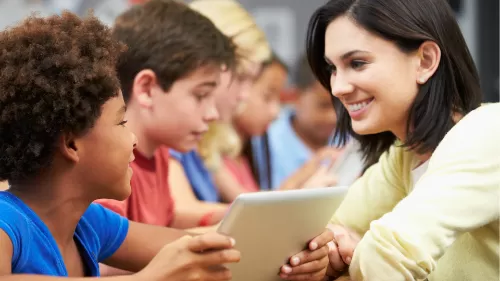Related searches

From Chalkboards to Cloud: The Infrastructure of Digital Learning
Traditional classroom tools have given way to high-speed internet, cloud-based collaboration, and interactive whiteboards. With platforms like Google Classroom, Canvas, and Microsoft Teams, educators can now organize lessons, assign work, and provide feedback seamlessly. Cloud integration means that assignments, resources, and even entire textbooks are available on-demand from any device. This shift not only promotes real-time collaboration between students and teachers but also ensures that learning continues beyond the four walls of the classroom—even during unexpected disruptions like snow days or public health emergencies.
Personalized Education Through AI and Data Analytics
One of the most exciting developments in Educational IT is the ability to personalize learning. With the help of AI-driven platforms such as Khan Academy, DreamBox, or i-Ready, teachers can tailor instruction to fit each student's learning pace, strengths, and areas for improvement. These systems use data analytics to track student performance and provide immediate feedback—empowering both teachers and learners. In a country where classrooms are increasingly diverse in learning needs, Educational IT is enabling more equitable and customized instruction, closing gaps that once seemed insurmountable.
Virtual Reality and Gamification: Making Learning Experiential
Gone are the days when students had to rely solely on textbooks and lectures. Thanks to innovations like Virtual Reality (VR) and gamification, Educational IT is creating immersive, engaging experiences that make abstract concepts tangible. Students can explore ancient Rome in 3D, conduct virtual chemistry experiments, or learn coding by playing game-like puzzles. These tools not only improve engagement and retention but also appeal to various learning styles. For visual or kinesthetic learners especially, VR and gamified content provide an experience that traditional education methods simply can’t match.
Supporting Teachers: Professional Development in the Digital Age
While Educational IT is student-focused, its success hinges on teacher readiness. Thankfully, IT has also transformed professional development for educators. Online workshops, micro-credentials, and learning management systems now provide teachers with continuous, on-demand training. Platforms like Coursera for Educators and Google for Education offer certification paths that help teachers stay ahead of the curve. Moreover, IT allows educators to connect across districts and states, forming virtual professional learning communities (PLCs) where ideas and resources can be shared freely and instantly.
Bridging the Digital Divide: Challenges and Equity in Access
Despite its potential, Educational IT isn’t without challenges—chief among them being the digital divide. Not all students in the U.S. have equal access to high-speed internet or personal devices at home, which can deepen educational inequities. Schools and districts have responded with initiatives like device-lending programs, community Wi-Fi hubs, and partnerships with tech companies. But the issue remains a pressing one. As policymakers and educators look to the future, expanding equitable access to Educational IT is crucial for ensuring that digital innovation benefits all learners, regardless of ZIP code.
Preparing Students for a Tech-Driven Future
Perhaps the most long-term impact of Educational IT lies in preparing students for a workforce increasingly dominated by digital tools and automation. From early exposure to coding to collaborative tools used in modern workplaces, students are acquiring both hard and soft skills essential for 21st-century careers. Educational IT fosters critical thinking, digital literacy, and project-based learning—skills that will empower students not just to consume technology, but to create with it. In essence, today's classrooms are training grounds for tomorrow's innovators, entrepreneurs, and problem solvers.
Educational IT Is Here to Stay—and Evolve
Educational IT is no longer an accessory to education—it is central to how we teach, how students learn, and how schools operate. While there are valid concerns about screen time, equity, and cost, the potential for Educational IT to promote engagement, personalization, and lifelong learning is undeniable. As technology continues to evolve, so too must our approach to using it wisely and equitably. With thoughtful integration, strong support for educators, and continued efforts to close access gaps, Educational IT can be the great equalizer that truly transforms education for all.
 How Can Teachers Use It in Instruction? Practical Strategies for the Modern Classroom
How Can Teachers Use It in Instruction? Practical Strategies for the Modern Classroom Transforming Classrooms: How Educational IT Is Reshaping Learning in America
Transforming Classrooms: How Educational IT Is Reshaping Learning in America Supporting English Learners in Today’s Classrooms: A Path to Equity and Opportunity
Supporting English Learners in Today’s Classrooms: A Path to Equity and Opportunity Understanding Dyslexia in Special Education: A Guide for Parents and Educators
Understanding Dyslexia in Special Education: A Guide for Parents and Educators Digital Literacy Lessons for Elementary Students: Teaching Tomorrow’s Skills Today
Digital Literacy Lessons for Elementary Students: Teaching Tomorrow’s Skills Today


